Why Was Daniele De Rossi Sacked?
Roma won 3-0 over the weekend in a dominant display over Udinese – but club icon Daniele De Rossi, who had previously been their manager since January, was not there after he was dismissed from his role following a poor start to the Serie A season.
De Rossi’s sacking has not gone well with the club’s fans, who are angry with the decision; this backlash caused the club CEO to step down.
De Rossi, who played over 400 games for Roma during his career, was axed by the club before the aforementioned win over Udinese after failing to win any of the opening four games this season.
Additionally, their 2023/24 campaign ended in similarly poor form, with just one win in the final five league games.
But what was the problem with Roma prior to the appointment of Ivan Jurić?
This scout report looks to answer that question with a tactical analysis of some of their key issues in the opening four games.
The analysis will also include various data to compare their start this season to their 2023/24 performance.
Some of the data from this season does include their stats from the win without De Rossi.
These stats will be marked with an asterisk next to them, and any data without that mark is data from De Rossi’s four games in charge only.
AS Roma Problems In Front of Goal
As we mentioned, Roma were one of the most dangerous teams in attack last season in the Serie A.
However, prior to Jurić’s arrival, they struggled to replicate that attacking form this season.
Certain data suggests that Roma were consistently creating chances under De Rossi—1.7 xG per 90 (6.74 total) from the opening four games is a promising foundation, but they managed two goals, so clearly, something isn’t clicking in the final stages of an attack.
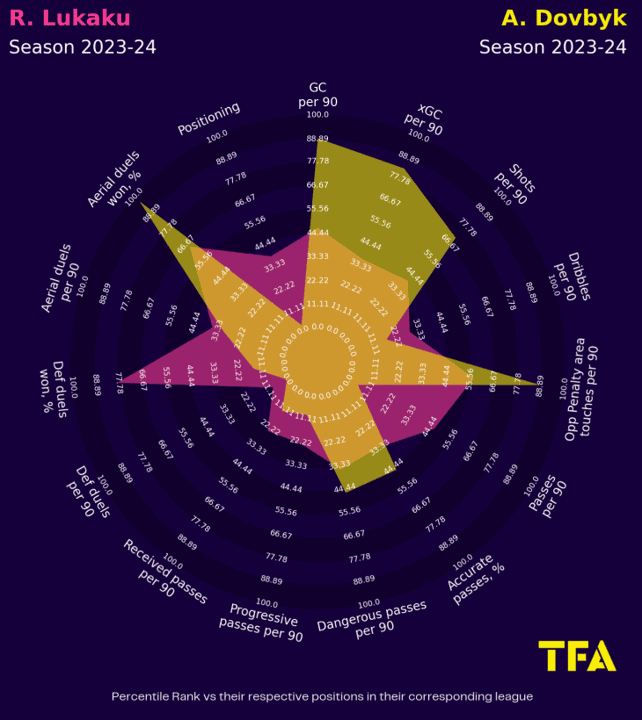
As you’ll know, Romelu Lukaku was Roma’s first choice number nine last season, with the Belgian contributing 16 G/A in 32 Serie games.
After his loan finished, he returned to Chelsea before making the permanent switch to Serie A rivals Napoli, meaning Roma were on the hunt for a replacement.
Artem Dovbyk was that replacement.
The now 27-year-old chipped in with an impressive 32 G/A last season for La Liga club Girona, and after a season like that, it’s likely that Roma weren’t the only club pursuing his signature.
Figure 1 above compares the performance of both players during the 2023/24 league campaign.
As you may expect, Dovbyk has a similar physicality profile to Lukaku—similar percentiles for aerial duels are an earlier indicator of that—but according to the data, Dovbyk is far more dominant in the air.
One area where the two differ somewhat is their movement up top—we’ve already seen glimpses of this in Dovbyk’s start in a Roma shirt; the Ukrainian tends not to drop in deeper to link up with midfield, partly because Roma’s system already has a high central presence in those areas.
He tends to sit on the last shoulder of the defender, with the occasional run-in behind if he thinks he can collect the ball in a good area.
That kind of positioning (higher up the pitch more consistently) means he is often ready and waiting in the box when Roma do reach the final third or a crossing/passing position – Dovbyk’s 5.26 touches in the box per 90 (fifth-highest in Serie A this season) is a sign that this is an effective way of getting him involved in play in critical stages of an attack.
However, his average of just 2.18 shots per 90, which doesn’t even rank in the top 30 registers in Serie A, suggests that Roma need to provide more effective service to the big forward if he is to replicate last season’s scoring form.
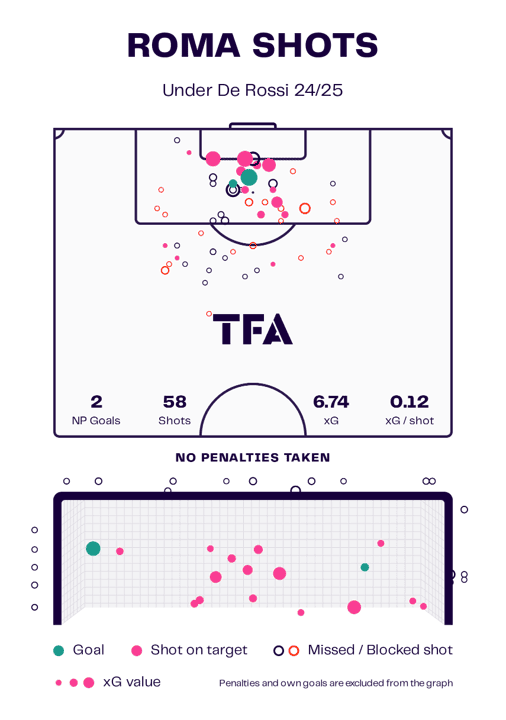
This image somewhat relates to the last point made regarding the quality of service into the box.
Just two goals from 58 shots is a worrying sign, and the visual above can give some idea as to why Roma are struggling in that sense.
Firstly, they clearly need to work on their threat from outside of the box or work on lowering the number of shots taken from ambitious ranges.
Secondly, there isn’t enough variety in shot locations – the majority of shots on target come from a very similar area, which could make it easier for teams to predict their moves in the latter stages of an attack.
Having said that, something has to be said for Roma simply not taking their chances inside the box.
Sure, you can’t expect every shot to go in, but there have been plenty of times when a finish in a good area has lacked that clinical edge.
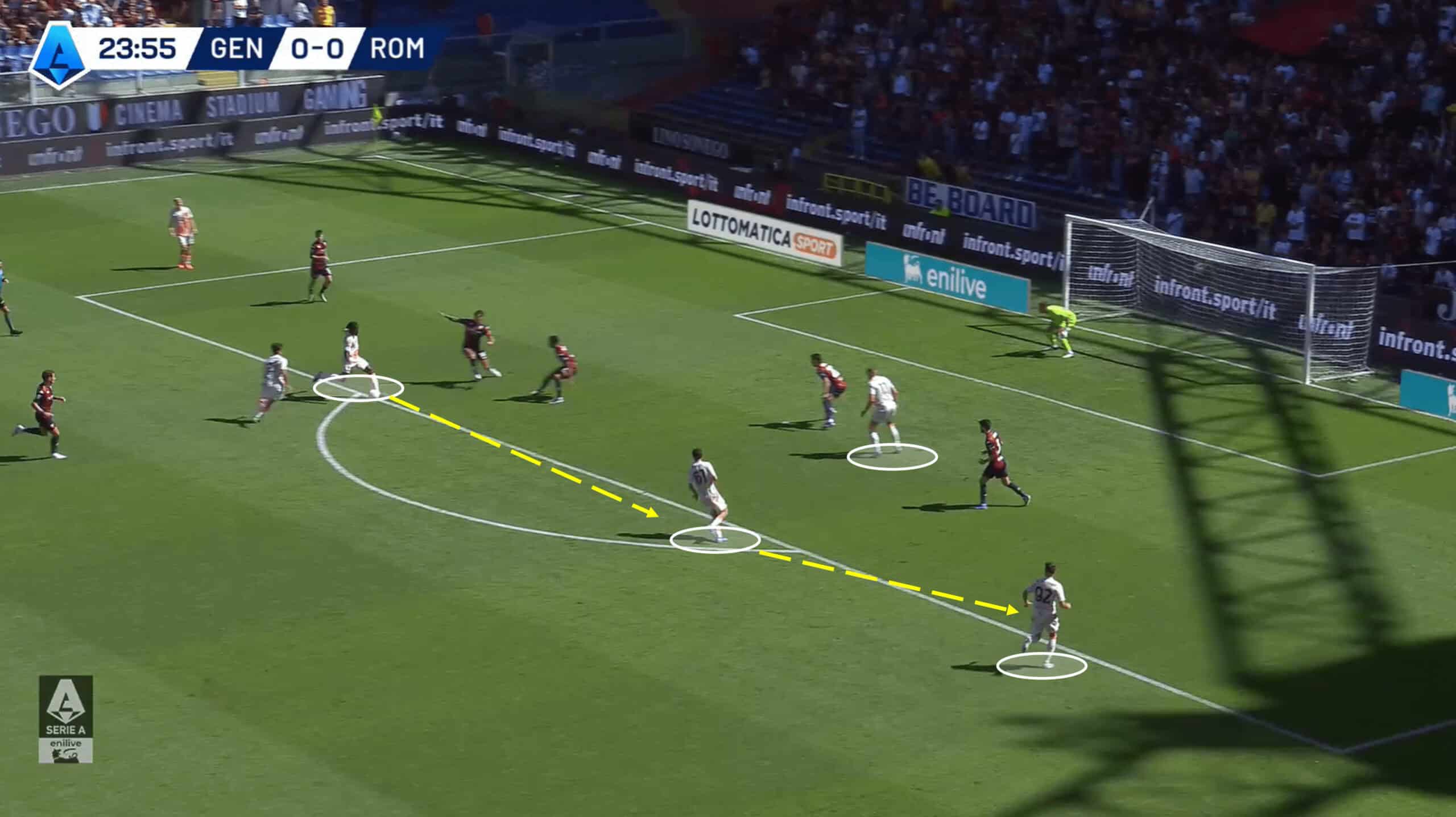
Finishing high xG chances isn’t the only thing that Roma lacked in those first four games under De Rossi.
Decision-making was also poor in many scenarios.
To De Rossi’s credit, Roma weren’t actually playing poorly in terms of early build-up play and shifting possession forward quickly and dangerously.
Still, individual errors and poor decisions in the final third really cost them.
Figure 3 above shows exactly this.
After breezing into the final third in an effective attacking transition move, Roma had a strong attacking presence, but poor decision-making killed the attack entirely.
The man on the ball did well to take the ball into the position he’s in.
Instead of playing the next pass over to the right-hand side of the box, where his teammates had a 3-to-2 numerical advantage over the opponent, he opted for an audacious attempt on goal despite having two opponents immediately in front of him to put him off.
Some may argue that De Rossi cannot be faulted for such individual moments in attack, given how good Roma can be in general play before the shot at the end.
Yet, others may suggest that as manager/head coach, it’s his duty to instil that collective mentality and cohesion into his players.
Additionally, with poor attacking decisions cropping up more consistently than he’d have liked, it would also be his duty to work on attacking scenarios on the training pitch.
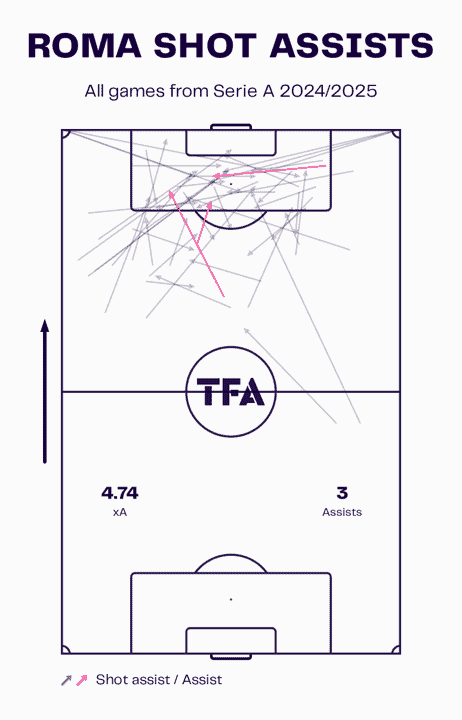
We mentioned that there could be the possibility of a lack of quality and variety to the deliveries in the box, and Figure 4 acts as evidence to this.
According to the data, hardly at all this season, even after De Rossi’s departure, have they provided a shot assist from anywhere near the byline.
Instead, the majority of their shot assists come from deep crosses into the box or short cut-backs for long shots.
AS Roma Increased Dribbling This Season
Last season, Roma’s numbers for dribbles and 1v1s were low – 18.13 per 90, which was the third-lowest in Serie A.
With the arrival of select individuals to try and boost this area, including Matías Soulé, Roma have successfully increased their engagement with dribbling, now averaging 24.39* per 90; one of the lowest success rates in the division, however, suggests they haven’t quite figured out how to utilise dribbling to best suit their tactics.
Soulé currently leads the charts for dribbles in Serie A, attempting 11.35 per 90, continuing his form from last season.
And with 42.5% of those dribbles being successful, there have been numerous times that he has been effective in moving the ball forward.
But are those dribbles suited to Roma’s tactics?
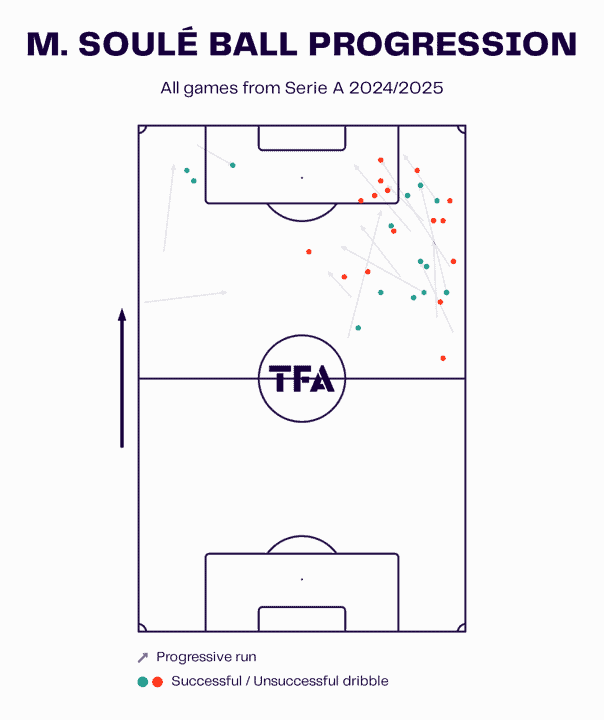
Now, we aren’t singling Soulé out as an individual at fault here, but he has the highest dribbling engagement in the league.
Hence, his data output serves as an excellent example of how Roma like to utilise dribbles, particularly in wide or central attacking areas.
This ties into the previous point about the variety in the location of chance creation, as it is rare that Soulé dribbles toward the byline—he instead prefers to start wider and drive inside.
However, the question raised here is this: Is that the most effective route in providing eventual service to Dovbyk, or anyone else for that matter?
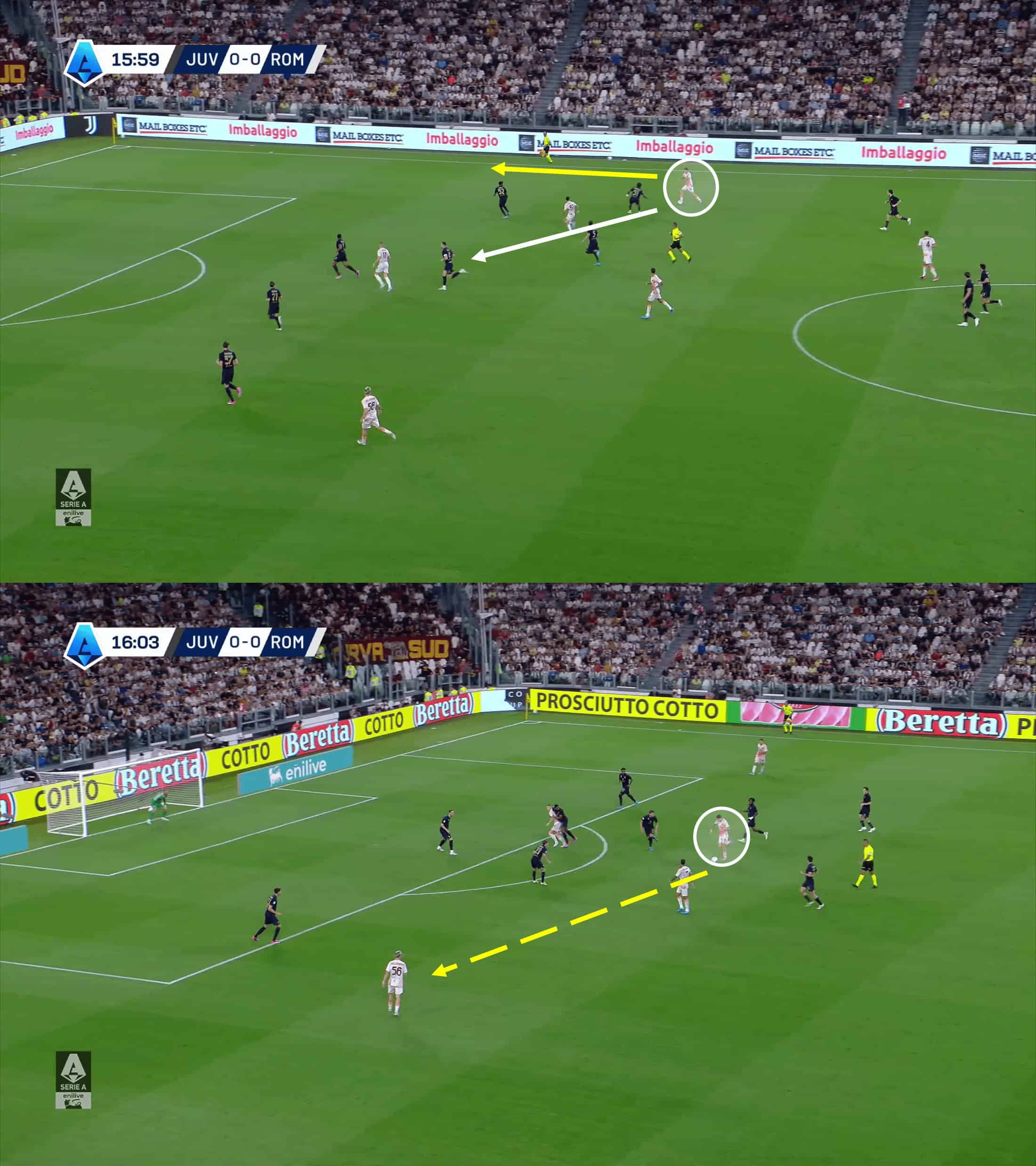
Decision-making can make or break a season, and Roma had a problem with that in the opening four games, likely for various reasons.
There’s the chance that frustrations were growing at the lack of goals, which meant players would try and force things in an attacking sense.
Soulé provided an example of that in the 0-0 draw against Juventus.
Following a dazzling run into a dangerous central area, the young winger opted for a pot shot from range that was highly unlikely to go in.
Yes, hindsight is a wonderful thing, and we can argue that, based on the notion that long shots are usually an unlikely chance, no player should ever take one – which would be boring!
However, Soulé had one, perhaps even two, perfectly good passing options to his left that could’ve furthered the attack to a greater end.
Decision-making is key.
The relevance here, though, is that Roma does have players with technical abilities to carry possession forward into dangerous areas.
Still, all of that goes to waste if they don’t make the right decision after carrying the ball all that way.
Another element that has seen an increase in Roma’s possession is their average possession per 90 minutes—last season, they averaged 54.1%, while this season, while De Rossi was in charge, that number surged up to 57.7%.
With this newfound increase in possession, it is possible that Roma have somewhat lost the ability/tendency to launch quick attacks from deeper areas, as evidenced by a significant drop in their engagement with progressive passes.
Conclusion
In truth, Daniele De Rossi’s sacking is probably a harsh one—especially this early in the season when performances weren’t actually too bad; they just needed things to click in the final third.
However, if that 3-0 win over Udinese is a sign of things to come, Ivan Jurić seems to have got things clicking in attack for Roma and then some.
His appointment came rather quickly after De Rossi’s dismissal – perhaps the Roma board felt that Jurić’s experience, game management, and man management were better suited to this Roma squad.

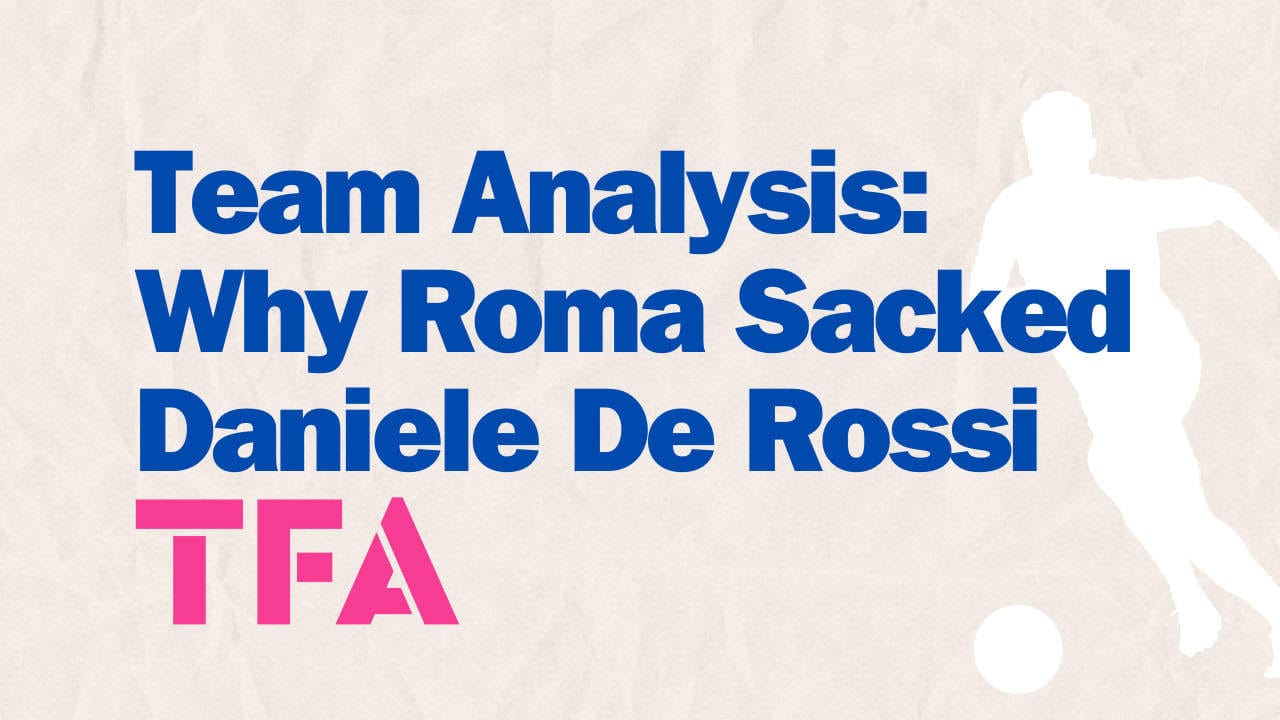




Comments